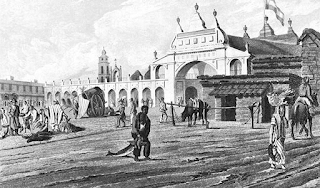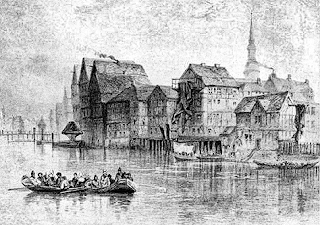
|
|
Scale: 10ft. Click here for a PDF version of this adventure! |
Room Key
A - Entry
A stairwell to the South opens into a large space. Along the North wall is a pool - semi-circular - which is ankle-deep with a mild acid. Bones - some of which are oversized - appear to have been thrown into the pool. Characters exposed to the acid will feel discomfort, but suffer damage only if exposed for a long period: 1 point per turn.
Organic equipment will be destroyed in a similarly slow fashion if submerged.
B - The Tooth Stealer
The North wall of the space presents a mosaic depicting Elves. The Elves do not appear quite right - they have a gray pallor to them and no whites to their eyes. If the party investigates further, they find that the lighter colored tiles of the mosaic are made from the teeth of humanoid beings. In so doing, the investigator must Save vs Spells or have their own teeth transposed: replaced with porcelain from the mosaic. A character so affected may not eat Iron Rations - as they will crack the new teeth: something preceded by discomfort, which the character would notice - however gains a +2 bonus going forward if exposed to Saves vs Poison via ingestion only.
The door to the South is stuck.
C - Cube Disposal
Inside this space, a Gelatinous Cube (B35) is moving from corner to corner, clockwise, in perpetuity. The floor and walls have a sheen to them that is remarkably clean. Inside the cube is suspended 84 ep, 66pp, and a Shield +1, which also grants DR 3 vs Acid and Acid Attacks: protected from the corrosive innards of the cube by its enchantment.
D - Projection Chamber
Against the West wall, several broken chairs and divans are propped. The East wall is smooth stone. Above the dilapidated seating, an 8 inch hole is seen in the wall, from which light emits. There are two inlaid metal squares in the hole - in its floor and ceiling - which will turn if pressed.
If the tesseract from Room M is inserted into the hole, it will project up to eight images onto the far wall, depending on how it is positioned. Five of these images depict Elves - black eyed and gray, as in Room B - performing day to day actions; two of the images depict landscapes similar to the surrounding landscape, except trees or shrubs are more barren and bear thorns where thorns might not normally be found; one of the images shows a blurry map of the dungeon, omitting secret doors, but showing room traps for rooms I, L, M, and numbered item 1. It is difficult to copy down from the seating area, but becomes easier if a character stands close to the wall.
Against the East wall in the center is a pit trap - 15 feet deep - dealing 2d4 falling damage to anyone caught in it.
E - Treasure Trove
The door to this space is nondescript: faux stone inlaid in the wall which, if discovered, is controlled by a locking mechanism behind a single stone in the center. Within the room can be found 3 gemstones worth 10 gp each, 5 gemstones worth 50 gp each, 2 gemstones worth 100 gp each, 500 platinum pieces, 1,000 gold pieces, and a Sword +1 (+3 vs Dragons).
F - Blind(folded) Guardians
This room is a wreck. A central dais has been desecrated and furniture - broken but well used - adorns the space amid a strong scent. Five Ogres (B40) - each with bandana or blindfold, but wearing it on the forehead or around the neck, as though positioned for ease of use - are feasting on a greasy, nauseating meal. Among the possessions of the Ogres are the keys to Room G.
The secret door is partially hidden behind a weapons rack being used for laundry. It will not open from this side.
The door to the South is heavy (as Stuck); the door to the West is locked.
G - Prison
Six Bugbears (B32) are imprisoned behind iron bars. The door to the room is locked. They are unarmed - having been taken captive by the Ogres in Room F - and will try to bargain with the party to set them free: their objective is to retrieve the sword in Room E, but they do not know precisely where it is - only that the Medusa in Room K is its possessor. They will, if the party helps them, be at best neutral - that is, they will not attack outright, but if it suits their objectives or furthers their wealth, they do not hesitate to betray the party after other dangers have passed and the sword has been retrieved.
H - Central Corner
A chandelier hangs in the center of this space above the heads of the party. No blood; though only 1/3 of the candle holders have candles (unlit) in them.
I - The Junction
A carpet sprawls across the floor - red with orange trim - in an octagonal shape concentric to the walls. The door to the South is stuck. The door to the East is a trap. If opened, a mirror is revealed behind it and spears jab out from the frame. THAC0 16, 2d8 damage.
J - Throne Room
Against the North wall, a large throne - enough for a man and a half - and tall, rests. On the left and right are braziers - unlit, but with cool ashes in them. There is a velour ottoman by the throne which, if investigated, will open - revealing 400 silver pieces within a storage compartment.
If the characters attempt to pull up the seat of the throne, they will find that it reveals a space underneath. Halflings have no trouble crawling in - man-sized characters have to crouch. This leads to a door hidden behind the throne in the North wall, which will open if a cord - situated nearby, under the throne, as well - is pulled.
The door must be manually shut. It does not automatically close after a character goes through.
K - Statue Garden
A well opens in the South-West part of the room. In the North-West part, a dozen or so petrified adventurers, in various poses, have been arranged around a lush divan. Occupying the space is a Medusa (B39). The Medusa carries no treasure, but wears a key on a necklace. The key will open the secret door to Room E.
L - South Corner
A chandelier hangs in the center of this space above the heads of the party. There is a tint of blood on it; no candles. A character stepping under the chandelier will trigger a trap where the chandelier falls: Save vs Paralysis or take 2d6 damage. A generous referee may allow a character to apply a bonus to the save based on armor worn.
M - Chamber of the Ringed Tesseract
Ringing the floor of this room are metal plates. The metal plates are dark, rusted, with washes of blood in several places, and perforated with holes around two inches in diameter, each, in a consistent pattern. A skeleton lies in one corner, a puncture visible through its skull.
The center section of the room is not floored by plate, but stone - as the rest of the dungeon. There are three small pinholes - in the center of the South, West, and East faces where the plate meets the stone. Resting here is an end table, on which can be seen several pieces of colored glass and a metal-rimmed tesseract: its top square slightly askew such that the sides are twisting along its height. The sides are crystal - similar to the colored glass - multicolored: an oil-type sheen. If a character casts light through it, abstract images may appear on the wall on the far side - as described in Room D - but unless the alignment is perfect (distances, volume of light cast, etc.) the image will be difficult to define.
Stepping into the center section will activate a trap.
The metal plates ringing the room fall to a depth of about 10 feet: any character on them at that time must Save vs Paralysis or fall with them. Pikes are positioned to come out of the holes: any character failing their save will take 2d8 damage - resetting itself after 1 turn has elapsed. A generous referee may allow a bonus to the save based on armor worn.
There is a box with three pins embedded in the South wall: not obvious, but easily found by a searching character: if the pins are placed into the three pinholes around the center section, the trap is disabled and will not fire until the pins are removed.
To a collector, the strange cube is worth 1,000 gold pieces.
Numbered Points of Interest
-
Pit trap, 10x10, 20 feet deep, Gelatinous Cube (B35) in the bottom. Inside
the cube is floating 400 silver pieces, 600 gold pieces, and a Potion of
Cure Light Wounds, protected from the acid by its glass exterior and
stopper.
-
Fountain with a fanged face, no water. If water is put in it, it begins to
flow, but only the left fang sprays water. If the right fang is twisted, it
swivels and opens the secret door.
-
A stone statue, photo-realistic, of a female magician. She is pointing South, but looking North, towards the junction to Room I. If the
adventurers search where she is pointing, they may find a hidden cord
between two flagstones: if pulled, it will unlock the secret door to
Room J.
- A stone statue, photo-realistic, of two adventurers: a man and a Halfling, facing West. The man is holding a lantern: no oil, but it is still functional.
Public domain and open licence art retrieved from
Pixabay or the National Gallery of Art and adapted for
thematic use. Attribution in alt text.




























